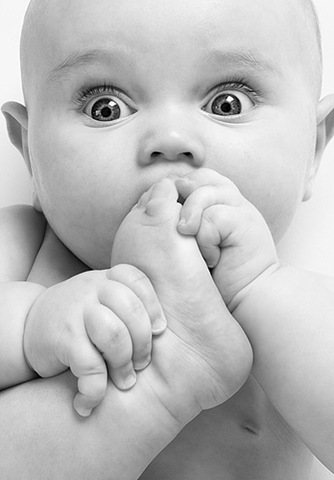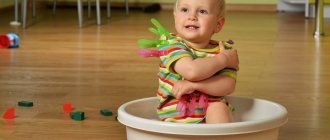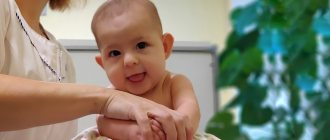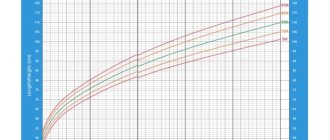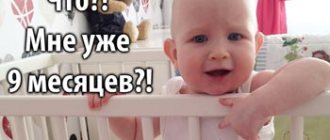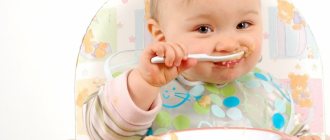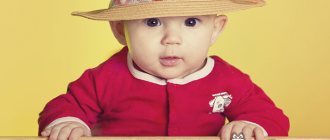The first year for any baby, whether it is a girl or a boy, is characterized by rapid development. The third month is a special time for a baby: colic has subsided, so the conditions for sleep and wakefulness have improved, the baby has learned to entertain himself and occupy himself for a short period of time. Therefore, most parents have a natural question: how to develop a child at 3 months at home, whether it is worth teaching him something or how to play with him for benefit and health.
Baby at 3 months
Development norms
Three months is the moment when every parent notices that the baby smiles back, makes funny sounds, understands the mother’s speech and always tries to joyfully respond to her smile, holding out his hands. Most adults immediately begin to teach the baby something, pronounce all the words clearly, and read about how to develop a 3-month-old baby at home.
Important! First of all, you should pay attention to how a three-month-old baby should develop, which is the norm, and only then begin to engage in development with him, if there is a need for this and in order to improve current indicators.
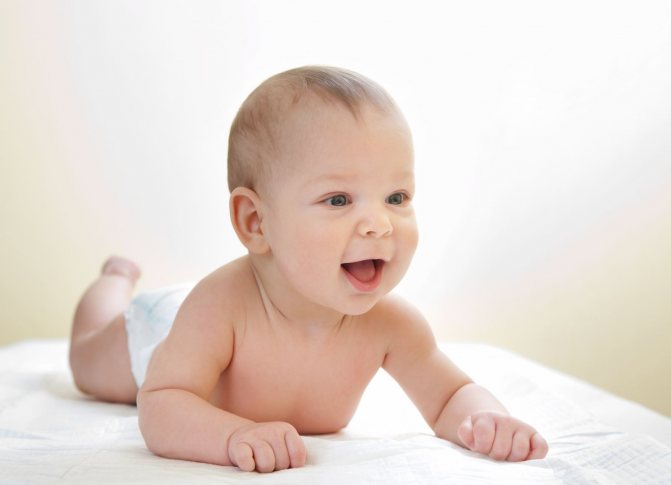
The baby holds his head well, lies steadily on his tummy and can push off the surface
Child development norms
| Category | Characteristics |
| Physiological changes | • Subcutaneous adipose tissue is well developed, and the presence of plump cheeks is often noted. • The muscular system develops from top to bottom. By this period, the hypertonicity of the hands disappears, so the child begins to try to take, touch, and shake everything. • Extinction of many reflexes. The search, proboscis and Babkin reflexes must be absent. • Development of the digestive system. The baby begins to eat more milk. Apart from it or the mixture, you should not add anything to the diet. • Regular and uniform stool. While breastfeeding, it can be 1 time every 2-5 days, or 5 times a day. |
| Physical development | • Boys’ weight is 5-8 kg, girls’ weight is 4.5-7.5 kg. • Height of boys – 57.3-65.5 cm, girls – 55.6-57 cm. • Head circumference of boys – 38.1-42.9 cm, girls – 37.1-42 cm. |
| Other skills | • Lying on his tummy, the baby can hold his head well. On his back he begins to turn on his side. • Vision: the child studies objects for a long time, especially highlighting those that move faster than others. Lying on his tummy, he can lift himself up onto his forearms to get a better look at something. • He hums for a long time and pronounces not only vowels, but also adds consonants to them. • The child’s emotionality increases, especially reacting joyfully to his mother. Loves the singing of an adult, the pleasant melodies of toys. He reacts to what he doesn’t like with sharp and loud crying. • “Tastes” the world, especially his fingers and fists. |
Educational toys for three months
Babies at 3 months adore objects that squeak, rustle, in a word, make any sounds. Therefore, the “toy of the month” can be called a rattle. It needs to be placed in the baby’s fingers and shaken slightly - the child must understand where the sound is coming from by raising his hand with the toy.
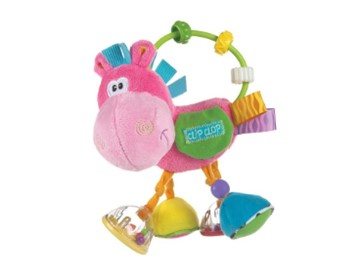
The rattle can be not only plastic, but also soft. This toy is made of bright materials of different textures, has a sound element inside that makes a squeaking sound, and the rattle handle crunches when pressed.
The multifunctionality of the item allows you to activate the baby’s auditory and visual perception, improves fine motor skills, forms the grasping reflex and manual dexterity.
Playing with a bell will develop your toddler's thinking. To do this, you should ring them so that the baby can see it, then remove the bell from the child’s field of view and ring again. The baby must look for the missing object with his eyes.
You can put a musical toy in the next room, take the little one in your arms and go with him in search of sound, saying: “Can you hear the music?”, “Who is singing?”, “Let’s go and see!” The search should not be delayed; the baby may quickly lose interest in the idea. When a musical object is found, one should express joy: “Here it is. We found a singing toy!
The baby is attracted to garlands of objects of different shapes and textures, attached with an elastic band to the side of the crib or stroller. Children like to reach out to hanging toys and touch them.
Among the best educational toys for three-month-old children, it should be noted:
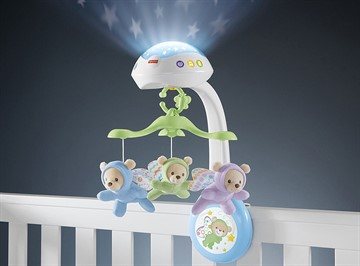
- musical carousel (mobile) with 3-4 toys . The hanging structure is attached above the crib so that the baby can see all its details. The rotation of the carousel is accompanied by a pleasant melody, forcing the child to focus his sight and hearing on it;
- mirror and luminous toys. They will capture the baby's attention for a long time;
- comforters . These cloth handkerchief toys are considered a must-buy for babies. They have no sharp corners, and the size, color and patterns are optimally selected. Comforters develop thinking, stimulate vision and touch, and have a calming effect on the baby.
You can place a tumbler within reach, the little one will try to get the toy and hear its melodic ringing. To make it easier for your child to rock the tumbler, you should tie a ribbon to it and secure the other end to the baby’s arm. Very quickly the baby will understand that any of his movements causes the sound of the toy, the child will like this, and he will do it again and again.
You can buy an educational ball toy for your baby. It is made of multi-colored fabrics with sewn loops and knots. There is a rattle inside. By touching the details of the ball with your fingers, the baby will hear a pleasant ringing sound. Preference should be given to objects of simple shapes, bright, but small in size so that the baby can comfortably hold them in his hands.
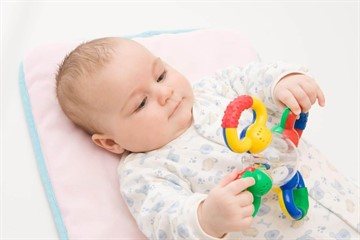
The toy should not be “overloaded”: the abundance of moving rings and spinning fragments is not yet of interest to the baby, since he cannot pick them up with his tiny fingers.
A feature of the psycho-physical development of a baby at this age is the study of his body. The child can look at his fingers and toes for a long time, clench and unclench his fists and pull them into his mouth.
Interest in this research process should be maintained by offering the baby the following entertainment: during wakefulness, you should sit next to the baby on the sofa or on the floor. By placing the baby on your lap, you can begin the game.
You need to smile at the baby, drawing his attention to your face. Then take the little one’s hand and ask: “Where is mommy’s nose? We are looking, looking, here he is!”, and then touch your nose with the baby’s hand. In the same way, you need to “look” for the baby’s nose, eyes, and mouth.
Games that the baby liked in previous months should be repeated periodically. You need to try to gradually supplement and complicate the activities so that they retain their developmental effect and are still interesting for the child.
Developmental activities
Olga Teplyakova, an expert on the intellectual development of children, can tell you what to do with a child or how to keep two children with a small age difference occupied at once. There are many of her classes, recommendations, and answers to parents’ pressing questions available and freely available on the Internet.
How to develop a baby at 2 months
Any developmental activities initially relate to the physical and nursing development of the baby. Therefore, before moving on to intellectual exercises, you need to be sure that the baby is physically strong.
A set of developmental activities:
- Do gymnastics and exercises every morning. To do this, it is enough to bend and unbend the legs and arms. You can use a fitball: lay the baby on his tummy, hold him by the legs and rock him.
- 2-3 times a week massage the whole body, starting with stroking, ending with light pats and relaxation.
- At 3 months, begin introducing exercises that encourage the baby to roll over. You should put the baby on his back, throw his leg over the other and try to stimulate the baby to turn over. A few hard studies and he will understand what's what.
- In order for the baby to begin to rise on his forearms and hold his head more often, you can also train him: lay him on his tummy, place bright toys nearby in different places. He will want to look at them, which will make him sit up. This exercise also improves the muscle corset.
- Place rattles and bells in the baby's hands as often as possible. He will look at them and ring. It is best to hang such toys in the baby's crib so that he can reach them.
- Show your baby the reflection in the mirror and say hello to him.
- Sing a lot with the child, say his name, pause so that the baby responds by humming.
- It is necessary to develop tactile sensitivity with objects with different surfaces: hard, rough, soft samples.
- During a walk, if the baby is not sleeping, show him nature, trees, animals, birds.
- Listen to music of different styles. During wakefulness – active, before sleep – calm. Classical music is very good for such purposes.
- Take bright rubber toys and balls with you when swimming. The baby will try to catch them.
Pronunciation of sounds, perception of names
In the third month, the child already understands that he is being addressed and recognizes his name. He also reacts sharply to the intonation of an adult, who creates a feeling of security for him. Therefore, you should always monitor the emotion with which the words are spoken, and under no circumstances should you yell at your baby, much less physically hurt him.
When an adult enters a child’s room, the baby is able to turn towards the sound and focus a long look at the parent. In response to mom or dad's words, he begins to twirl his arms and squeal. Pediatricians call this moment “comprehensive revitalization.” The child is already beginning to initiate communication.
In his speech, the walking sounds of vowels and consonants slip through: “g..k..khy..ma..ata..ama..i..y..”.” When he experiences special joy, you can even hear the following sounds: “agu, boo, boom, bam, pl, pf, aph.”
Note! If you don’t communicate with your baby, he won’t make any sounds for a long time. Therefore, speech will be somewhat delayed.
Also at this time, the baby begins to giggle and laugh loudly.
Development of coordination
When a baby has well-developed coordination, he will subsequently move deftly, skillfully, and have correct posture.
Games for developing coordination with a three-month-old baby are static and dynamic.
Static - those with the help of which the baby maintains balance in a certain position. You can try to lift the baby’s legs while saying “hop-hop”, as if “tapping” the name in the air, then release your hands for a few seconds so that the baby tries to hold them. It is very important to do everything in a calm state and at a slow pace.
Dynamic – active exercises. For example, put the baby on his tummy and place your palms on his feet. The baby will try to push off with his legs. Thus, he acquires the skill of crawling.
In addition, you can periodically place your baby on your lap, stroke his back, head, and hum a slow song while rocking him at the same time.
Note! You cannot overdo it with such activities. If the baby is tired or capricious, you should immediately stop any kind of manipulation, otherwise the child will subsequently not want to participate in any games.
Motor skills
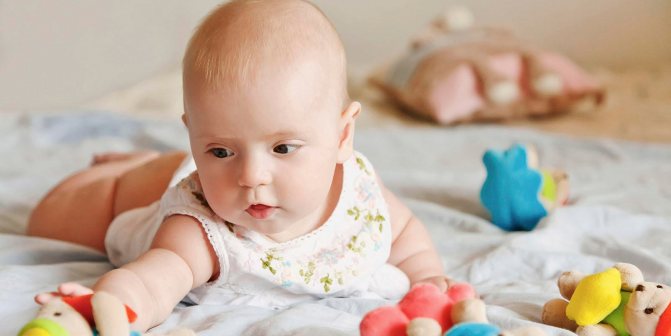
The baby begins to reach for objects and hold them in his hands
During this period, the baby’s movements are still imperfect and at times chaotic. The reason for this is that hypertonicity is just beginning to recede. Parents should engage in active exercises with him more often. For example, put it on his tummy, try to show him which toy to reach for, then help him roll over. The baby will shake his legs and arms. Monitor the baby's reaction; it is important not to scare him.
Also, at 3 months, the baby learns to push off from one side of the crib to the other. This gives him great pleasure.
Hearing development
It is best to ask all family members to participate in hearing development. Then the baby will immediately hear different voices and understand that the same sounds sound at different pitches.
Set of exercises:
- Buy the same toy in different sizes, for example, a bell. While playing, try to ring different bells, showing which one the sound comes from.
- Let's listen to classical music. No matter how difficult it may seem to an adult, the baby learns such works quickly and later begins to recognize them from the first notes. Listen for no more than 5 minutes at first.
- You can start singing lullabies with words.
Vision development
At this time, the baby begins to skillfully track the movement of objects. Children's doctors recommend making the task more difficult: carrying toys over longer distances, increasing the range of movements. This way the baby’s horizons will expand.
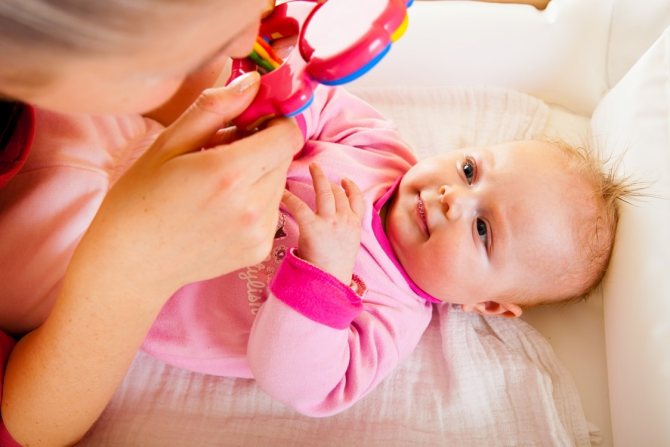
The baby can track the movement of objects
Additional Information. If the movements are smooth, the baby will learn to slowly turn his head. You can try playing “hide and seek”, but do everything slowly: bring an object to your face that will cover your face, say “peek-a-boo”, then slowly remove it from your face. After a while, you will see that the baby keeps his eyes on the parent for a long time, despite the fact that his face may be hidden.
Third month of life - exercise
